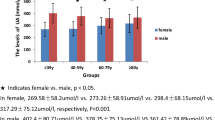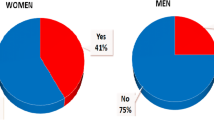Abstract
The prevalence of coronary artery disease (CAD) is growing in the young population. We aimed to investigate the association between serum uric acid (SUA) levels and cardiovascular involvement in individuals under 45 years old diagnosed with early-onset CAD (EOCAD). Seven hundred eighty-six EOCAD patients were recruited and stratified into four groups by SUA levels. General information, serum indicators, and results of coronary angiography and echocardiography were recorded. The associations between SUA levels were explored by univariate and multivariate logistic regressions. With the increasing of SUA levels, the prevalence of hypertension and hyperlipidemia, triple branches involved, heart failure, and cardiac enlargement of left ventricle (LV), left atrium (LA), and right ventricle (RV) were significantly higher (all P < 0.05). The fourth group (SUA >8 mg/dl) had the highest proportions than other groups (all P < 0.05). After controlling potential confounders, multiple logistic regression analysis showed that odds ratios of SUA >8 mg/dl were 2.345 for triple branches involved (95 % confidence interval (CI) 1.335–4.119), 4.168 for heart failure (95 % CI 1.599–10.862), and 4.122 for LV enlargement (95 % CI 1.874–9.065) (P < 0.05). SUA >8 mg/dl was independently associated with triple branches involvement, heart failure and LV enlargement in Chinese EOCAD patients. Higher SUA level might play an important role in cardiac dysfunction and severity of EOCAD.
Similar content being viewed by others
References
Vaisi-Raygani A, Ghaneialvar H, Rahimi Z et al (2010) The angiotensin converting enzyme Dallele is an independent risk factor for early onset coronary artery disease. Clin Biochem 43:1189–1194
Hata J, Kiyohara Y (2013) Epidemiology of stroke and coronary artery disease in Asia. Circ J 77:1923–1932
Che J, Li G, Shao Y, Niu H, Shi Y (2013) An analysis of the risk factors for premature coronary artery disease in young and middle-age Chinese patients with hypertension. Exp Clin Cardiol 18:89–92
Yang ZJ, Liu J, Ge JP, Chen L, Zhao ZG, Yang WY (2012) Prevalence of cardiovascular disease risk factor in the Chinese population: the 2007–2008 China National Diabetes and Metabolic Disorders Study. Eur Heart J 33:213–220
Sharma M, Ganguly NK (2005) Premature coronary artery disease in Indians and its associated risk factors. Vasc Health Risk Manag 1:217–225
Reibis R, Treszl A, Wegscheider K, Bestehorn K, Karmann B, Völler H (2012) Disparity in risk factor pattern in premature versus late onset coronary artery disease: a survey of 15,381 patients. Vasc Health Risk Manag 8:473–481
Fang J, Aldeman MH (2000) Serum uric acid and cardiovascular mortality: the NHANES Iepidemiologic follow-up study, 1971-1992. JAMA 283:2404–2410
Okura T, Hiqaki J, Kurata M et al (2009) Elevated serum uric acid is an independent predictor for cardiovascular events in patients with severe coronary artery stenosis: subanalysis of the Japanese Coronary Artery Disease (JCAD) Study. Circ J 73:885–891
Duran M, Kalay N, Akpek M et al (2012) High levels of serum uric acid predict severity of coronary artery disease in patients with acute coronary syndrome. Angiology 63:448–452
Li YH, Lin GM, Lin CL, Wang JH, Chen YJ, Han CL (2013) Relation of serum uric acid and body mass index to mortality in high-risk patients with established coronary artery disease: a report from the ET-CHD registry, 1997-2006. J Cardiol 62:354–360
Kanbay M, Segal M, Afsar B, Kang DH, Rodriguez-Iturbe B, Johnson RJ (2013) The role of uric acid in the pathogenesis of human cardiovascular disease. Heart 99:759–766
Papežíková I, Pekarová M, Kolářová H et al (2013) Uric acid modulates vascular endothelial function through the down regulation of nitric oxide production. Free Radic Res 47:82–88
Khosla UM, Zharikov S, Finch JL et al (2005) Hyperuricemia induces endothelial dysfunction. Kidney Int 67:1739–1742
Puddu P, Puddu GM, Cravero E, Vizioli L, Muscari A (2012) Relationships among hyperuricemia, endothelial dysfunction and cardiovascular disease: molecular mechanisms and clinical implications. J Cardiol 59:235–242
Corry DB, Eslami P, Yamamoto K, Nyby MD, Makino H, Tuck ML (2008) Uric acid stimulates vascular smooth muscle cell proliferation and oxidative stress via the vascular renin-angiotensin system. J Hypertens 26:269–275
Kang DH, Han L, Quyang X et al (2005) Uric acid causes vascular smooth muscle cell proliferation by entering cells via a functional urate transporter. Am J Nephrol 25:425–433
Jin M, Yang F, Yang I et al (2012) Uric acid, hyperuricemia and vascular diseases. Front Biosci 17:656–669
Baldwin W, McRae S, Marek G et al (2011) Hyperuricemia as a mediator of the proinflammatory endocrine imbalance in the adipose tissue in a murine model of the metabolic syndrome. Diabetes 60:1258–1269
Wang H, Jacobs DR Jr, Gaffo AL, Gross MD, Goff DC Jr, Carr JJ (2013) Longitudinal association between serum urate and subclinical atherosclerosis: the Coronary Artery Risk Development in Young Adults (CARDIA) study. J Int Med 274:594–609
Maynard C, Fisher LD, Passamani ER, Pullum T (1986) Blacks in the coronary artery surgery study: risk factors and coronary artery disease. Circulation 74:64–71
Culleton BF, Larson MG, Kannel WB, Levy D (1999) Serum uric acid and risk for cardiovascular disease and death: the Framingham Heart Study. Ann Intern Med 131:7–13
Moriarity JT, Folsom AR, Iribarren C, Nieto FJ, Rosamond WD (2000) Serum uric acid and risk of coronary heart disease: Atherosclerosis Risk in Communities (ARIC) Study. Ann Epidemiol 10:136–143
Wheeler JG, Juzwishin KD, Einksdottir G, Gudnason V, Danesh J (2005) Serum uric acid and coronary heart disease in 9,458 incident cases and 155,084 controls: prospective study and meta-analysis. PLoS Med 2:e76
Facchini F, Chen YD, Hollenbeck CB, Reaven GM (1991) Relationship between resistance to insulin-mediated glucose uptake, urinary uric acid clearance, and plasma uric acid concentration. JAMA 266:3008–3011
Krishnan E, Pandya BJ, Chung L, Hariri A, Dabbous O (2012) Hyperuricemia in young adults and risk of insulin resistance, prediabetes, and diabetes: a 15-year follow-up study. Am J Epidemiol 176:108–116
Bedir A, Topbas M, Tanyeri F, Alvur M, Arik N (2003) Leptin might be a regulator of serum uric acid concentrations in humans. Jpn Heart J 44:527–536
Lyngdoh T, Marques-Vidal P, Paccaud F et al (2011) Elevated serum uric acid is associated with high circulating inflammatory cytokines in the population-based Colaus study. PLoS One 6:e19901
Onat A, Can G, Ornek E (2013) Elevated serum uric acid in nondiabetic people mark pro-inflammatory state and HDL dysfunction and independently predicts coronary disease. Clin Rheumatol 32:1767–1775
Kawamoto R, Tabara Y, Kohara K (2014) Interaction between serum uric acid and triglycerides in relation to prehypertension in community-dwelling Japanese adults. Clin Exp Hypertens 36:64–69
Liu Y, Jin C, Xing A et al (2013) Serum uric acid levels and the risk of impaired fasting glucose: a prospective study in adults of North China. PLoS One 8:e84712
Demirkol S, Balta S, Cakar M, Kurt O, Dinc M (2013) Is there any correlation between serum uric acid levels and right ventricular function parameters in patients with cardiovascular risk factors? Int J Cardiol 168:3086
Krishnan E, Hariri A, Dabbous O, Pandya BJ (2012) Hyperuricemia and the echocardiographic measures of myocardial dysfunction. Congestive Heart Fail 18:138–143
Chao TF, Hung CL, Chen SJ et al (2013) The association between hyperuricemia, left atrial size and new-onset atrial fibrillation. Int J Cardiol 168:4027–4032
Marijana T, Branislava I, Cesare C (2013) Metabolic syndrome and right ventricle: an updated review. Eur J Intern Med 24:608–616
Kuo CF, See LC, Yu KH, Chou IJ, Chiou MJ, Luo SF (2013) Significance of serum uric acid levels on the risk of all-cause and cardiovascular mortality. Rheumatology 52:127–134
Yamanaka H (2011) Japanese guideline for the management of hyperuricemia and gout: second edition. Nucleosides Nucleotides Nucleic Acids 30:1018–1029
Acknowledgments
The authors thank Dr. Jing-Min Zhou, Department of Cardiology, Zhongshan Hospital affiliated to Fudan University, for his kind suggestions to the study. This research received the funding of Shanghai Committee of Science and Technology Major Program (No. 11DJ1400101).
Conflict of interest
The authors declared that they had no conflicts of interest. There was no financial or personal relationship with other people or organizations that could inappropriately influence this work. We had full control of all primary data and allowed the journal to review the data if requested.
Author information
Authors and Affiliations
Corresponding author
Additional information
Xiao-Min Dai and Lei Wei contributed equally to this work.
Rights and permissions
About this article
Cite this article
Dai, XM., Wei, L., Ma, LL. et al. Serum uric acid and its relationship with cardiovascular risk profile in Chinese patients with early-onset coronary artery disease. Clin Rheumatol 34, 1605–1611 (2015). https://doi.org/10.1007/s10067-015-2878-1
Received:
Revised:
Accepted:
Published:
Issue Date:
DOI: https://doi.org/10.1007/s10067-015-2878-1




